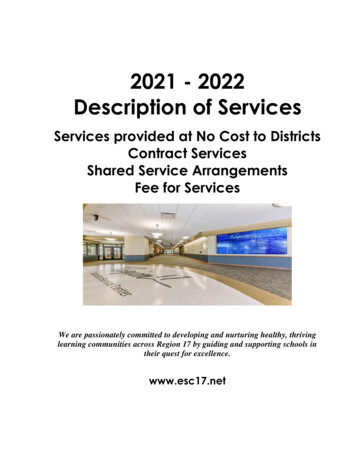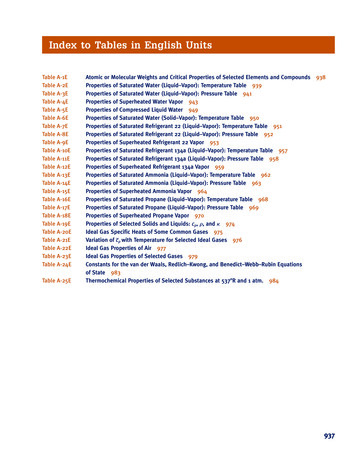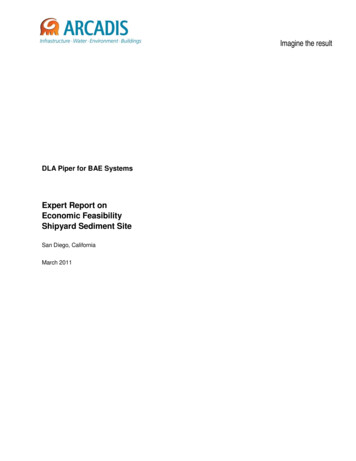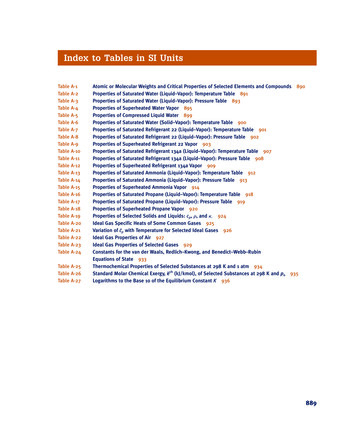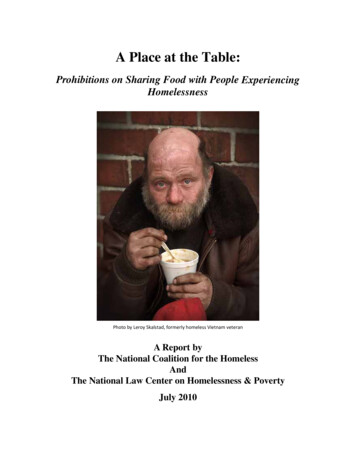
Transcription
A Place at the Table:Prohibitions on Sharing Food with People ExperiencingHomelessnessPhoto by Leroy Skalstad, formerly homeless Vietnam veteranA Report byThe National Coalition for the HomelessAndThe National Law Center on Homelessness & PovertyJuly 2010
The National Coalition for the HomelessThe National Coalition for the Homeless, founded in 1982, works to bring aboutsocial change necessary to prevent and end homelessness and to protect the rights ofpeople experiencing homelessness. NCH achieves this by engaging our membershipin policy advocacy, capacity building, and sharing solutions to homelessness with thegreater community. NCH is a national network of people who are currently or formerly homeless,activists and advocates, service providers, and others committed to ending homelessness. We arecommitted to creating the systemic and attitudinal changes necessary to prevent and end homelessnessand working to meet the immediate needs of people who are currently experiencing homelessness.Senior Management and StaffWashington, DC OfficeNeil DonovanExecutive DirectorMichael StoopsMegan HustingsDirector of Community Organizing Director of DevelopmentBob ReegDirector of Public PolicyJacob ReiterDirector, Faces of HomelessnessSpeakers’ BureauJoan DavisAdministrative AssistantMichelle LeeWebmaster/Graphic DesignerNational AmeriCorps Vista VolunteersPhillip Banze, Macon, GATiffany Barclay, Atlanta, GACarl Baty, Baltimore, MDChelsea Carnes, Gainesville, FLTracey Crocker, Tampa, FLEryn Dailey-Demby, Atlanta, GAMargaret Djekovic, Tampa, FLJacqueline Dowd, Orlando, FLClaudine Forbes, Atlanta,GALinda Gaines, Bradenton, FLPrincess Gaye, Tallahassee, FLMatthew Gazy, Macon, GALynne Griever, Athens, GAWilliam Griever, Athens, GALaura Guerry, Atlanta, GAChantell Justice, Miami, FLKatie Justice, Spartanburg, SCSteve Kever, Ft. Lauderdale, FLJaron Kunkel, Athens, GAMatthew Maes, Pensacola, FLWilliam McKinley, Atlanta, GAJohn Milster, Ft. Myers, FLTamara Patton, Jacksonville, FLEmily Richburg, Miami, FLG.W. Rolle, Pinellas Park, FLJonathan Schultz, Macon, GAAlexis Smith, Tallahassee, FLAmanda St. Jean,West Palm Beach, FLChristina Swanson, Tampa, FLAmanda Tremain, Macon, GAChristina Tudhope, Oviedo, FLPeter Wagner, Marathon, FLMary Weil, Tallahassee, FLJordon Weldon, Greenville, SCKen Werner, New Port Richey, FLJanis Wilson, Pensacola, FLKari Woodman, Daytona Beach, FL
Board of DirectorsOFFICERSJohn Parvensky, ECPresidentColorado Coalition for the HomelessDenver, COBrian Davis, ECVice PresidentNortheast Ohio Coalition for theHomelessCleveland, OHSue Watlov Phillips, ECTreasurerElm Transitional Housing, Inc.Minneapolis, MNMichael DahlGordon PackardHOME LineMinneapolis, MNPrimavera FoundationTucson, AZBob Erlenbusch, ECPhillip Pappas, ECSacramento Hunger CoalitionSacramento, CAPittsburgh, PAGlorin Ruiz PastushDiana V. FigueroaPrimavera FoundationTucson, ArizonaGreg SileoJoe FinnMassachusetts Housing ShelterAllianceBoston, MASherri Downing, ECSecretaryHugh GroganMontana Council on HomelessnessHelena, MTMinnehaha County Department ofHuman ServicesSioux Falls, SDDIRECTORSBarbara Anderson, ECLa Fondita de JesusSan Juan, PRBaltimore Homeless ServicesBaltimore, MDLouisa StarkPhoenix Consortuim for the HomelessPhoenix, AZSandy SwankInter-Faith MinistriesWichita, KSJeremy HaileHaven House ServicesJeffersonville, INLawyerWashington, DCAnita Beaty, ECLaura HansenFaces of Homelessness Speakers’BureauWashington, DCCoalition to End HomelessnessFort Lauderdale, FLRichard Troxell, ECTina HaywardHouse the Homeless, Inc.Austin, TXPartners to End HomelessnessVicksburg, MSMatias J. Vega, M.D.Metro Atlanta Task Force ForHomelessnessAtlanta, GABen Burton, ECMiami Coalition for the HomelessMiami, FLRey LopezMichael D. Chesser, ECUpstate Homeless Coalition of SouthCarolinaGreenville, SCThe King’s OutreachCabot, ARStephen ThomasAlbuquerque Health Care for theHomelessAlbuquerque, NMYvonne VissingPatrick MarkeeChandra CrawfordCoalition for the Homeless, IncNew York, NYUNITY of Greater New OrleansNew Orleans, LAPhoebe NelsonSalem State CollegeSalem, MADonald WhiteheadWomen’s Resource Center of NorthCental WashingtonWenatchee, WAFaces of Homelessness Speakers’BureauWashington, DC
NATIONAL LAW CENTER ON HOMELESSNESS & POVERTYThe National Law Center on Homelessness & Poverty (the Law Center) is the only national legaladvocacy organization dedicated to ending and preventing homelessness. Our attorneys go intocourtrooms and the halls of our legislatures to protect the needs of society’s most vulnerable members.Through impact litigation, policy advocacy and public education, we address the root causes ofhomelessness at the local, state and national levels. Established by attorney Maria Foscarinis in 1989and based in Washington, DC, the Law Center works with a wide variety of groups around the nation.You are invited to join the network of attorneys, students, advocates and activists who make upNLCHP’s membership. By becoming a member you can help make a difference in the lives of millionsof homeless Americans. For more information about membership, please visit our website atwww.nlchp.org/join us.cfm.Law Center Board of DirectorsVasiliki Tsaganos, ChairFried, Frank, Harris,Shriver & Jacobson LLPPeter BresnanSimpson Thatcher &Bartlett LLPMaria FoscarinisNational Law Center onHomelessness & PovertyEdward McNicholas,Vice-Chair,Sidley Austin LLPTonya Y. BullockState of MarylandHoward GodnickSchulte Roth & ZabelLLPMichael Allen,Treasurer MicrosoftCorporationBruce J. CasinoKatten Muchin RosenmanLLPMona Touma, SecretaryGoldman, Sachs & CoRoderick DeArmentCovington & BurlingLLPKenneth S. AnecksteinDLA PiperSally Dworak-FisherPublic Justice CenterKirsten Johnson-ObeyPorterfield & LowenthalLLCFather AlexanderKarloutsosGreek OrthodoxArchdioceseTashena MiddletonMooreSecond Chances HomeBuyers LLPG.W. RollePinellas Co. Coalition forthe Homeless, Inc.Bruce RosenblumThe Carlyle GroupMargaret PfeifferSullivan & CromwellJeffrey SimesGoodwin Procter LLPPamela MalesterCommunity VolunteerWilliam Breakey, M.D.Johns Hopkins UniversityLaw Center StaffAndy BeresGrant Writer/Communications AssistantMaria FoscarinisExecutive DirectorTaunya MelvinDirector of OperationsJeremy RosenPolicy DirectorKaren CunninghamLegal DirectorWhitney GentDevelopment &Communications DirectorRachel NatelsonDomestic ViolenceAttorneySarah ShubitowskiEmerson Hunger FellowGeraldine DoetzerHousing AttorneyJessica LibbeyDevelopment AssociateAn DuongHuman Rights FellowMarion ManheimerVolunteerTulin OzdegerCivil Rights ProgramDirectorEric TarsHuman Rights ProgramDirector/ Children &Youth Attorney
Table of ContentsAcknowledgements1Executive Summary2Methodology6Introduction7Myths About Homelessness and Food Access8Types of Food Sharing RestrictionsRestricting Public Property 161616Myrtle Beach, South CarolinaCincinnati, OhioDenver, ColoradoFort Lauderdale, FloridaLas Vegas, NevadaSan Juan, Puerto RicoSarasota, FloridaWilmington, North CarolinaOrlando, FloridaWest Palm Beach, FloridaSultan, WashingtonLittle Rock, ArkansasLimitations on Number of People ServedGainesville, FloridaZoning RestrictionsPhoenix, ArizonaSan Diego, CaliforniaPolice HarassmentHuntington, New YorkFood Safety RestrictionsMiddletown, ConnecticutAtlanta, GeorgiaMiami, FloridaNashville, TennesseeCleveland, OhioRight to Food17Constructive Alternatives to Food Sharing Restrictions191919202021212222Fort Myers, FloridaPortland, OregonSwipes for the Homeless – Los Angeles, CaliforniaFirst Helping – Washington, DCFree Farm – San Francisco, CaliforniaSt. Louis Bread Company Cares Café – St. Louis, MissouriFeeding America Backpack ProgramFederal Nutrition ProgramsPolicy Recommendations23Conclusions24
AcknowledgementsThe National Coalition for the Homelessness would like to thank all of its board members,staff and interns who greatly contributed to the research, writing, editing and layout of thereport.NCH thanks Donna Leuchten, Bill Emerson National Hunger Fellow—Congressional HungerCenter, who was NCH’s primary researcher and writer for this report. NCH also thanks TaniaMathurian, Notre Dame ‘12 who did research and writing and Michael Stoops, Director ofCommunity Organizing, for co-editing this report. NCH thanks its numerous local advocates,NCH Board Members, and friends across the country for their feedback and support.NCH acknowledges the generous support of the Presbyterian Church, USA Small Church andCommunity Ministry.The National Law Center on Homelessness & Poverty would like to thank the followingindividuals for their tremendous contribution to this report.In particular, the Law Center would like to thank Sarah Shubitowski, Bill Emerson NationalHunger Fellow—Congressional Hunger Center, who was the Law Center’s primary researcher andwriter for this report. The Law Center also thanks Eric Tars and Gil Rochbert for research anddrafting of the Right to Food Section of this report, and Tulin Ozdeger, Civil Rights ProgramDirector, for co-editing the report. The Law Center would like to thank Benjamin Cooper, KathrynLong, and Ryan Shadrick Wilson at Hogan Lovells for their assistance with legal research for thereport. The Law Center also wishes to thank the numerous local advocates and friends across thecountry who provided valuable information for this report.The Law Center acknowledges with gratitude the generous support of the Herb Block Foundation,Presbyterian Hunger Fund, and W.K. Kellogg Foundation.Finally, the Law Center would also like to thank its LEAP member law firms: Akin Gump StraussHauer & Feld LLP; Blank Rome LLP; Bruce Rosenblum; Covington & Burling LLP; DechertLLP; DLA Piper; Fried, Frank, Harris, Shriver & Jacobson LLP; Goodwin Procter LLP;Greenberg Traurig, LLP; Hogan & Hartson LLP; Jenner & Block LLP; Jones Day; KattenMuchin Rosenman LLP; Latham & Watkins LLP; Morrison & Foerster Foundation; O’Melveny& Myers LLP; Schulte Roth & Zabel LLP; Sidley Austin LLP; Simpson Thacher & BartlettLLP; Sullivan & Cromwell LLP; and WilmerHale.1
Executive SummaryThree years after the 2007 publication of Feeding Intolerance: Prohibitions on Sharing Foodwith People Experiencing Homelessness, cities still choose to implement measures thatcriminalize homelessness and, at times, penalize those who serve homeless persons. Thesemeasures, such as anti-camping laws, often target activities homeless people are forced to do inpublic spaces because of their lack of a home or shelter.This report specifically focuses on ordinances, policies, and tactics that discourage or prohibitindividuals and groups from sharing food with homeless persons. Uncomfortable with visiblehomelessness in their communities and influenced by myths about homeless people’s foodaccess, cities use food sharing restrictions to move homeless people out of sight, an action thatoften exacerbates the challenges people experiencing homelessness face each day just to survive.The report also highlights constructive alternatives to food sharing restrictions, in the form ofinnovative programs that both adults and youth are implementing to share food with peopleexperiencing homelessness in their communities.Increasing Homelessness and Hunger Across the U.S.Many people are confronting homelessness and hunger in the current economic recession,some for the first time. The 2009 Hunger and Homelessness Survey conducted by the U.S.Conference of Mayors1 found: 82% (22 of 27) of cities surveyed, in 2009, reported having to make adjustments toaccommodate an increase in the demand for shelter over the past year. 25% of requests for emergency food assistance went unmet in 2009. 26% was the average increase in demand for assistance reported by cities in 2009, whichrepresents the largest average increase since 1991.Growing Restrictions by Cities on Food SharingMore cities have chosen to target homeless individuals by restricting groups or individuals whoshare food with homeless people in private and public spaces, since 2007. Examples of thesemeasures include:1U.S. Conference of Mayors, Hunger and Homelessness Survey: A Status Report on Hunger and Homelessness inAmerica’s Cities—a 27-City Survey 7 (2009).2
Gainesville, Florida began enforcing a rule limiting the number of meals that soupkitchens may serve to 130 people in one day.2 Phoenix, Arizona used zoning laws to stop a local church from serving breakfast tocommunity members, including many homeless people, outside a local church.3 Myrtle Beach, South Carolina adopted an ordinance that restricts food sharing withhomeless people in public parks.4 Although permits are free, groups may only obtain apermit four times a year.5Legal Challenges and Human Rights ImplicationsSuch restrictions raise legal issues, and some have been challenged in court. For example: In Orlando, Florida the American Civil Liberties Union (ACLU) filed a lawsuit againstthe City of Orlando on behalf of local organizations, challenging a 2006 law requiring agroups sharing food with 25 or more people to obtain a permit that was only availabletwice a year per park. A federal district court found the law to be unconstitutional and inviolation of Free Exercise of Religion and Freedom of Speech in October of 2008.6 Thecity has appealed the decision and the appeal is pending. In San Diego, California the zoning department attempted to prohibit a local church fromserving a weekly meal to community members, many of them homeless.7 In 2008,attorney Scott Dreher successfully defended the church's First Amendment right topractice its religion. The weekly meal continues to take place on church property andserves 150 to 200 people each week.8Such restrictions also raise human rights concerns. The right to food is a recognized human right,explicitly addressed in over 120 instruments of international law since 1920 and included in thedomestic constitutions of 22 nations.9 The International Convention on Economic, Social andCultural Rights (ICESCR) explains that states have an obligation to respect, protect and fulfillcertain rights. For the right to food this means a state, or nation, must not take action resulting inpreventing access to food, must ensure that enterprises or individuals do not deprive someone oftheir access to food, and must take proactive action to increase access to food.102Gainesville, Fla., Code A6 § 30-11.Jenna Davis, Meals for Needy Irk Church’s Neighbors, The Arizona Republic, July 31, 2009.4Myrtle Beach, S.C., Code § 8.2009-20 (2009).5MB Ordinance to Limit Mass Feeding for Homeless, WMBF News.com, June 9, 2009.6ACLU Florida Chapter, Federal Judge Strikes Down Orlando Homeless Feeding Ban7Ronald Powell, City to allow food-for-needy program, Union-Tribune, April 22, 2008.8Email from Pastor April Herron, Pacific Beach United Methodist Church, to NCH. (On file at NCH).9Food and Agriculture Organization of the United Nations, Fact Sheet, available ts/food.pdf.10Substantive Issues Arising in the Implementation of the International Convention on Economic, Social andCultural Rights: General Comment 12, Committee on Economic, Social and Cultural RightsE/C.12/1999/5 12May 199933
Constructive Alternatives to Food Sharing RestrictionsDespite the prevalence of food sharing restrictions that hinder access to food for individualsexperiencing homelessness, there are examples of positive ways hunger is being addressed.These examples include the expansion of existing federal nutrition programs, innovative newprograms, and collaboration between cities and local service providers. Some examples include: The city of Ft. Myers, Florida abandoned plans to limit food sharing programs that servehomeless individuals in public parks, due to a negative public response to the proposal, in2007. Subsequently, a city council member and local service providers collaborated toaddress community concerns surrounding public food sharing. Ultimately, the citycouncil promised to work with local homeless service providers to create a Hunger TaskForce, which has strengthened local alliances and resources.11 In Los Angeles, California Jonathan Lee, while a student at UCLA, recognized that therewere hundreds of unused student meal plan meals at the end of the semester andidentified those as potential meals and snacks to be donated to people experiencinghomelessness and hunger in the community. He recruited help and started Swipes for theHomeless, a quarterly program that collects hundreds of donated meal card swipes fromtheir peers.12 A federal program, the EBT Restaurant Meals Program, allows people experiencinghomelessness to use SNAP/Food Stamp benefits at authorized restaurants. Participationis up to each state, and while many states do not take advantage of the program, it hasexpanded in the several states that do. California’s Los Angeles County has 477restaurants participating in the program, including Subway, Dominos Pizza, El PolloLoco and Jack in the Box. Michigan and Arizona also have restaurants participating, andFlorida is in the process of implementing a pilot program.13Policy Recommendations Cities should collaborate with food sharing groups to effectively address the problems ofhunger and homelessness. Local authorities should reach out to food sharing groups tocoordinate the provision of food and educate providers on how to help homeless personsaccess emergency and social services. Communities should assist homeless persons in accessing federal, state, and local foodsecurity benefits, including SNAP, WIC, and child nutrition programs.11Email from Janet Bartos, Executive Director, Lee County Homeless Coalition, Ft. Myers, Florida, to NationalLaw Center on Homelessness and Poverty, April 20, 2010 (on file with the National Law Center on Homelessness& Poverty).12Katvitha Subramanian, Swipes for the Homeless Collects Leftover Meals for Cause, Daily Bruin, March 11,2010, available at neral Accounting Office, “Homelessness: Barriers to Using Mainstream Programs” (2000).4
The U.S. Department of Agriculture and/or the U.S. Interagency Council onHomelessness should provide trainings and technical assistance to communities to aidthem in developing constructive alternatives to food sharing restrictions. The U.S. Congress and the U.S. Department of Agriculture should improve the homelesspopulation’s access to the Supplemental Nutrition Assistance Program (SNAP), formerlyknown as Food Stamps, and homeless service providers’ access to the Child and AdultCare Food Program (CACFP), a program that allows shelters to receive reimbursementfor meals served to children up to age 18 residing there.5
MethodologyRecognizing that food is a basic human need and right, the National Coalition for the Homeless(NCH) and the National Law Center on Homelessness & Poverty (the Law Center) aim toprovide an accurate description of some of the local responses to hunger among homelessindividuals in their communities. This includes both restrictions that prohibit individuals andorganizations from sharing food in public settings and constructive alternatives to restrictionsthat have been developed to increase access to healthy food for homeless people.NCH and the Law Center compiled information for A Place at the Table: Prohibitions onSharing Food with People Experiencing Homelessness from various sources. Newspaper articlesregarding food sharing restrictions were collected from both local and national news sourcessince 2007. Web research was then conducted in order to follow up on newspaper articles, andto locate other incidents of and alternatives to food sharing restrictions. Specifically,Municode.com was used to locate relevant existing city ordinances.In addition to print and online sources, stories and other information from local homelessadvocates and homeless people around the country were a main resource for this report. NCHand the Law Center reached out to their networks and allies at the community level who, eachday, work to support men and women experiencing homelessness.6
IntroductionIn 2007, the National Coalition for the Homeless (NCH) and the National Law Center onHomelessness & Poverty (the Law Center) worked collaboratively to publish FeedingIntolerance: Prohibitions on Sharing Food with People Experiencing Homelessness. The reportdrew attention to the disturbing national trend of penalizing the act of sharing food with men,women, and children experiencing homelessness. Three years later, cities are still implementingthese measures through ordinances, policies, and tactics that discourage or prohibit individualsand groups from sharing food with homeless persons. Uncomfortable with visible homelessnessin their communities and influenced by myths about homeless peoples’ food access, cities usefood sharing restrictions to move homeless people out of sight, an action that often exacerbatesthe challenges people experiencing homelessness face each day.One example of these attitudes, often referred to as NIMBY (Not-in-My-Backyard) attitudesis evident in the new “Welcome to Ocean Beach, Please Don’t Feed Our Bums” bumperstickers, t-shirts, and hats that are causing controversy in one California town. Theseproducts, modeled after a sign asking residents not to feed bears, embody the messages thathomeless people are not wanted and that by feeding them, people are enabling them toremain living on the local streets. The products sold at a local store, The Black, represent theattitudes that are at the root of many of the laws created or used to restrict food sharing withhomeless people throughout the country.14This report first provides a brief overview of the problem,including how homelessness and hunger have changed since2007. The report examines the right to food, and breaks downthe various ways that cities across the country have chosen totarget homeless individuals by implementing food sharingrestrictions. Additionally, the report highlights constructivealternatives to food sharing restrictions, in the form of innovativeprograms that both adults and youth are implementing to sharefood with people experiencing homelessness in theircommunities. The goal of this report is to educate and paint abroader picture of how cities around the country are respondingto the growing problem of hunger in their communities.Over 2009 and 2010,the number ofAmericans experiencinghomelessness during thecourse of a year isprojected to increase by1.5 million.Many people are confronting homelessness and hunger in the current economic recession, somefor the first time. The baseline number of people who are homeless over the course of a year isestimated to be approximately 3 million, and is projected to increase by 1.5 million over 2009and 2010 because of the recession.15 As cities pursue measures that both discourage and prohibit14John Wilkens, Please Don’t Feed Our Bums Controversial Bumper Stickers Target New More Aggressive Type ofTransient, San Diego Union-Tribune, June 18, 2010.15National Alliance to End Homelessness , Homelessness Looms as a Potential Outcome of the Recession, Jan. 23,2009.7
sharing food with people without homes, most cities cannot meet the growing need for services,food, shelter, or affordable housing.In 2009, 22 of the cities surveyed by the U.S. Conference of Mayors reported having to makeadjustments to accommodate an increase in the demand for shelter over that year. Shelters withan inadequate number of beds to meet increased need have turned to overflow cots, chairs,hallways and other sub par sleeping arrangements. Some cities have come to rely on vouchers tohotels and motels when shelters no longer have beds available.16Homeless people not only struggle with lack of shelter and housing, but alsowith hunger. In November 2009, the U.S. Department of Agriculture (USDA)reported that more than 49.1 million Americans lived in households strugglingagainst hunger in 2008,17 13 million more than in 2007.The Mayors' Survey also documented a sharp increase for hunger assistance.In 2009, cities reported a 26% increase in demand for assistance, on average,which represents the largest average increase since 1991. All but one of thesurveyed cities reported an increase in requests for emergency foodassistance compared to 74% of surveyed cities in 2007. The requests foremergency food assistance that went unmet increased from 23% to 25%.18Myths about Homelessness and Food AccessThere are a number of myths that exist about homeless individuals and their access to food thatlead to the attitudes and laws that restrict food sharing in public settings. These myths aretremendously detrimental to the efforts to provide homeless men, women, and children with thebasic necessities for survival.Myth: Hunger is not a problem for homeless individuals because there are plenty of foodpantries and soup kitchens.Food pantries do not effectively meet the needs of people without homes because homelesspeople lack the facilities to store and prepare food. Many food pantries, also, limit the number ofboxes you can receive, some to only twice in six months. Additionally, cities often do not haveadequate food available through soup kitchens to serve all those in need three times a day, sevendays a week. Sometimes it is falsely assumed that people who are homeless are able to walk ortravel. Unfortunately, homeless people may not be able to travel significant distances for fooddue to work conflicts, illness, disability or lack of adequate public transportation.16U.S. Conference of Mayors, Hunger and Homelessness: A Status Report on Hunger and Homelessness inAmerica’s Cities—a 27-City Survey 7 (2009).17USDA,Economic Research Report No. (ERR-83) 66 pp, November 2009.18U.S. Conference of Mayors, Hunger and Homelessness: A Status Report on Hunger and Homelessness inAmerica’s Cities—a 27-City Survey 7 (2009).8
Myth: SNAP/Food Stamp benefits are easily accessible to people who are homeless andmany homeless people take advantage of this program.According to the most recent statistics available, over half of the homeless population does notreceive food stamps.19 Lack of transportation, lack of knowledge about the program, mentalillness, lack of an address and lack of documentation are some of the common barriers thatprevent homeless people from receiving food stamps.Myth: Sharing food with people in outdoor locations enables them to remain homeless.Food sharing programs that reach out to people in public spacesmay be the only way for some people experiencing homelessnessto have access to healthy and safe food. Work conflicts, illness,disability, and lack of public transportation are all reasons ahomeless person might not be able to make it to an indoor foodsharing program. People do not remain homeless because ofoutdoor food sharing programs; people remain homeless forreasons that include a lack of affordable housing, shelterspace, living wage or significant life events such as divorce,domestic violence or illness.Food sharing programs thatreach out to people in publicspaces may be the only wayfor some people experiencinghomelessness to have accessto safe and healthy food.There is not one face of homelessness. Stereotypes misrepresent the diversity of individualsand experiences of life without a home. Communities must work collaboratively to providefood and shelter to those who cannot attain it without help. Ordinances and policies thatdiscourage or prohibit the act of sharing food with people experiencing homelessness isimmoral and, in some cases, contrary to domestic and international law.Types of Food Sharing RestrictionsThe goal of food programs that serve homeless people is to provide nutritious, filling and safefood to individuals who do not typically have consistent access to healthy food. In addition,many food sharing programs aim to build community or provide access to supportive services.Some food sharing groups are motivated by religious reasons, and may provide both food and theability to join their congregation in a religious service. These are ways groups go above andbeyond the key component of providing food, which all people have a human right to access.Cities have taken different measures to restrict food sharing with people experiencinghomelessness, denying their basic rights to food. Requiring a permit for public property use,limiting the number of people who can be served, imposing zoning restrictions, and selectivelyenforcing ordinances are examples of policies and practices that restrict food sharing. Thissection of the report will discuss specific cities’ use of such tactics.19General Accounting Office, “Homelessness: Barriers to Using Mainstream Programs” (2000).9
Restricting Public Property UseMany cities have laws regarding the use of public parks, and 12 of those cities have reported thatthese laws have specifically limited groups from being able to share food with homeless people.One way use is limited is through permit requirements. The permits can be limiting and forcefood sharing groups out of areas where they have historically been able to reach many homelesspeople.Of the 23 cities we surveyed, 12 cities have at some point limited the use of public parks forsharing food with homeless people. Some of these communities put a limit on the number ofpeople that can congregate in a public park ranging from 25 to 75 people. Others restrict usingthe parks as a place for “social services.” Still other cities restrict the use of parks in certainareas of the city, or limit how often parks can be used to share food.For example, in 2009, the Myrtle Beach, South Carolina City Council passed an ordinance thatrestricts food sharing with homeless people in public parks.20 The ordinance requires foodsharing groups to apply for a permit and comply with the State Health Department’srequirements. Although the permits
Cleveland, Ohio 16 Right to Food 17 Constructive Alternatives to Food Sharing Restrictions 19 Fort Myers, Florida 19 Portland, Oregon 19 Swipes for the Homeless - Los Angeles, California 20 First Helping - Washington, DC 20





